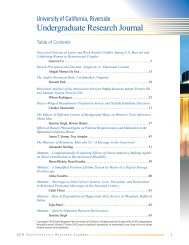Glassy-Winged Sharpshooter Population Survey and Xylella ...
Glassy-Winged Sharpshooter Population Survey and Xylella ...
Glassy-Winged Sharpshooter Population Survey and Xylella ...
Create successful ePaper yourself
Turn your PDF publications into a flip-book with our unique Google optimized e-Paper software.
<strong>Glassy</strong>-<strong>Winged</strong> <strong>Sharpshooter</strong> <strong>Population</strong> <strong>Survey</strong> <strong>and</strong> <strong>Xylella</strong> fastidiosa Detection<br />
C<strong>and</strong>ice A. Sanscartier<br />
Introduction<br />
Pierce’s Disease is a bacterial disease of grapevines, first<br />
recognized by Newton Barry Pierce in the late 1800’s<br />
near Anaheim, California. To date, the disease has been<br />
documented in vineyards from California to Florida <strong>and</strong><br />
along the East Coast as far north as Virginia (Hoddle, 2004;<br />
Wallingford et al., 2007). Affected grapevines develop<br />
leaves that are discolored <strong>and</strong> dried out, <strong>and</strong> they usually<br />
die within 2-5 years (Hopkins, 1989). The disease is caused<br />
by infection with the bacterial pathogen, <strong>Xylella</strong> fastidiosa,<br />
which multiplies in the xylem of plants, forming a gellike<br />
biofilm that blocks water flow to the rest of the plant<br />
(Hopkins, 1989).<br />
(Redak et al., 2004). Insect emergence takes place within<br />
2 weeks of egg laying, adults remain active throughout the<br />
summer, then the numbers decrease in early fall (Redak<br />
et al., 2004). The Pierce’s Disease pathogen is transmitted<br />
most during summer when GWSS populations are at their<br />
highest (Almeida et al., 2005).<br />
X. fastidiosa is an insect transmitted bacterium that lives only<br />
in the xylem of the infected plant. The xylem is responsible<br />
for transporting water throughout the plant. The insects<br />
feeding on the xylem transfer the pathogen from the infected<br />
plants to healthy plants. There are several pathogenic strains<br />
of X. fastidiosa each of which is associated with a specific<br />
host plant causing diseases in different plants from various<br />
families (Hopkins, 1989). X. fastidiosa infections are seen<br />
more often in areas with mild to high temperatures. These<br />
temperatures are also ideal for the insect vector, Homalodisca<br />
vitripennis, which is frost sensitive <strong>and</strong> thrives best in hot<br />
climates (Johnson et al., 2008).<br />
H. vitripennis, most commonly known as the <strong>Glassy</strong>-<strong>Winged</strong><br />
<strong>Sharpshooter</strong> (GWSS), is one of many leafhopper species,<br />
referred to as sharpshooters (Figure 1). These sharpshooters<br />
feed on the xylem fluid, thus transmitting X. fastidiosa to<br />
the plant. The GWSS appears to be a much more effective<br />
vector of the pathogen than most other sharpshooter<br />
species. This ability has been attributed to the insect’s high<br />
mobility, wide distribution, <strong>and</strong> ability to have many hosts<br />
(Almeida et al., 2005). Transmission of the pathogen can<br />
occur immediately after the GWSS has acquired the bacteria<br />
(Hopkins, 1989). This species has become well established<br />
<strong>and</strong> widely distributed in Southern California since its<br />
accidental introduction in early 1990’s, making it very<br />
difficult for wineries to control the disease. Although GWSS<br />
have many hosts, they mainly reside on citrus plants where<br />
egg laying occurs during the late winter <strong>and</strong> early spring<br />
Figure 1. Photo of adult H. vitripennis http://cisr.ucr.edu/ssp_<br />
director/albums/album-9/lg/glassy-winged_sharpshooter_gwss-<br />
6.jpg.<br />
Pierce’s Disease is a persistent threat to the $30 billion<br />
wine industry encompassing 890,000 acres of vineyards<br />
across Southern California. In 2000, PD affected 30% of<br />
California grape crops <strong>and</strong> has likely increased since then<br />
(Toscano et al., 2006). As a result of this disease, the vine<br />
growers have turned to intense use of chemical insecticides<br />
for the containment of GWSS. This widespread use of<br />
insecticides often prevents us from surveying the natural<br />
patterns of X. fastidiosa occurrence in relation to GWSS<br />
<strong>and</strong> the grapevines. We obtained access to unsprayed<br />
grapevines in AgOps fields on the UCR campus, which<br />
gave us the opportunity to conduct a rare survey of GWSS<br />
visitations in a natural environment. The information<br />
collected allows us to examine visitation patterns as well<br />
as patterns of the natural infection of GWSS carrying the<br />
bacterium, X. fastidiosa. Such information will contribute<br />
to underst<strong>and</strong>ing the insect-pathogen-plant dynamics of<br />
the PD system <strong>and</strong> aid in the development of more efficient<br />
management skills in controlling the disease.<br />
3 2 U C R U n d e r g r a d u a t e R e s e a r c h J o u r n a l














